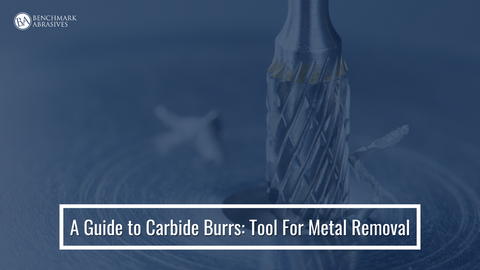
A Guide to Carbide Burrs: Tool For Metal Removal

Carbide burrs, often called rotary files, are small, high-speed cutting tools used to cut, shape, grind, and remove excess material, sharp edges, and burrs. They work effectively on a vast array of materials, including wood, plastics, acrylics, cast iron, steel, aluminum, and even high-strength alloys like Inconel and Inox.
Carbide burrs are staples in metalworking, toolmaking, engineering, jewelry making, wood carving, and especially in industries requiring high-precision deburring, weld preparation, and material removal from confined spaces, such as in the production of aircraft and turbine parts.
What are Carbide Burrs?
Carbide burrs are highly durable cutting tools made from Tungsten Carbide, a composite material second only to diamond in hardness. This extreme hardness allows the burrs to rotate at very high speeds without quickly dulling, ensuring efficient and precise material removal.
Carbide Grade and Coatings
The material itself is a cemented carbide, composed of Tungsten Carbide powder bound together by Cobalt. The quality is measured by its grade (e.g., C2 or C5), which dictates the burr's hardness and heat resistance. For very high-heat applications, such as on specialized aerospace materials, some carbide burrs feature advanced coatings including titanium nitride (TiN) or aluminum titanium nitride (AlTiN).
These rotary files operate by being securely clamped into a die grinder, straight grinder, or high-speed rotary tool (like a Dremel) and spun at high RPMs to perform the cutting action.
WAYS TO SELECT A CARBIDE BURR
Selecting the right carbide burr depends entirely on the workpiece material, the rotary tool you are using, and the desired final cut. The selection process involves choosing the correct burr shape, fluting style (cut), and operating speed.
1. Burr Shape
The shape determines the type of surface or contour the burr is designed to create.
| Shape Name | ISO/Common Name | Primary Application |
| Ball/Spherical | C | Hollowing out material, creating concave cuts, and rounding edges. |
| Cylindrical | A | Flat surface finishing, deburring straight edges. |
| Tapered | L, K | Chamfering (rounding off) edges, contour shaping in narrow areas. |
|
Round Nose Tree |
M, N | Grind curved surfaces, clean hard-to-reach inner corners. |
| Inverted Cone |
D |
Creating sharp undercuts and back-chamfering. |
| Countersink | J | Beveling or enlarging pre-drilled holes. |
2. Fluting Style (Cut)
The fluting style, or the grooves on the burr's surface, dictates how material is removed and the resulting finish.
- Single-Cut (One Flute): These have a single, up-cut, right-handed spiral flute. They are best for rapid material removal and are commonly used on cast iron, steel, ferrous metals, and copper. They produce long chips and are ideal for cleaning and deburring.
- Double-Cut (Diamond Cut): These are the most popular and widely used options available. They have a second set of flutes cut in the opposite direction, producing a cross-hatch pattern. This design allows for smaller chip removal and finer surface finishing. These are suitable for use on aluminum, soft steel, non-ferrous metals, wood, and plastic.
- Coarseness: Flutes also come in ratings of fine, standard, and coarse. This refers to the size and spacing of the flutes, which further refines the finish quality.
3. Shank Size and Burr Size
The shank is the stem that fits into your tool's collet. Standard sizes are 1/8 inch (3 mm) for rotary tools and 1/4 inch (6 mm) for die grinders. The burr size is measured by its cut length and diameter, which determines the overall size of the cut or chamfer you can create.
Guidelines for Safe Use and Optimal Speed
The Inverse Speed Rule
The speed at which the burr spins (RPM) is the most critical factor for performance and safety, and it is inversely proportional to the burr's diameter.
The main goal is to maintain the correct surface feet per minute (SFM) for the material. A larger bur has a larger circumference, which means it reaches the correct SFM target at lower RPMs.
| Burr Diameter (Approx.) | Maximum Recommended RPM | Result of Running Too Slow |
| 1/4 inch (6 mm) | 25,000 - 35,000 RPM | Ragged finish, chattering, and clogging flutes. |
| 1/2 inch (12 mm) | 12,000 - 15,000 RPM | Tool failure, excessive heat, and vibration/snagging. |
Running a large burr too fast is dangerous, leads to premature burr failure, and creates excessive heat. Always start slowly and increase the speed gradually until the tool cuts efficiently without chattering.
Safety Considerations
- Clamping: Ensure the bur shank is inserted as far as possible into the collet and securely clamped to minimize overhang and reduce vibration.
- Pressure: Apply minimal pressure. Pushing too hard downward can lead to snagging, chipping, and poor finishes. Let the speed and the burr's cutting edges do the work.
- PPE: Always wear face and eye protection (a face shield is best) and securely fasten your workpiece before operating the tool.



































































